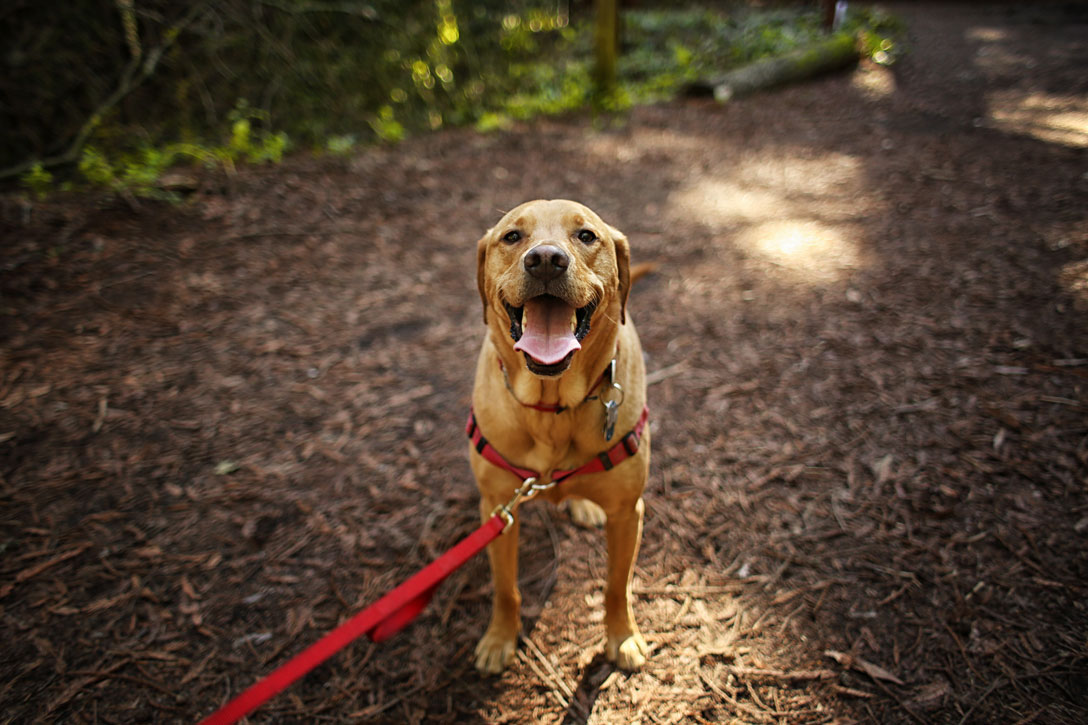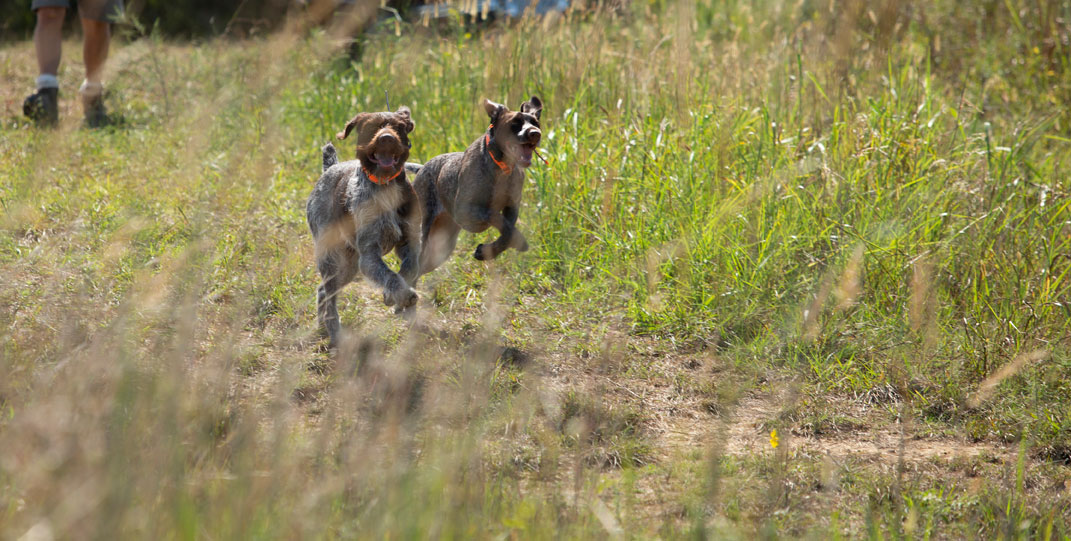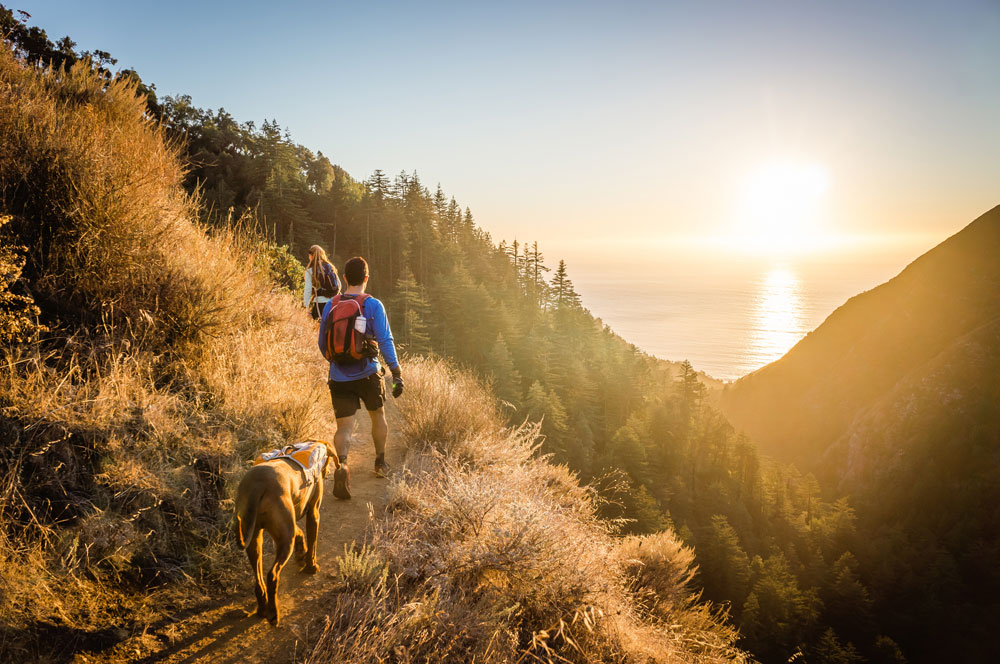Hiking is a challenging and fun activity, but hiking with dogs is unbeatable. When you’re in the great outdoors with a canine companion by your side, you experience all the benefits of solitude, fresh air, and quietness, yet the perfect hiking partner accompanies you. More than just an exercise or hunting buddy, your dog alerts you to danger and helps you navigate diverse terrain. Because you love hiking with your dog as much as we do, we’d like to share these helpful safety tips for hiking with dogs.

1. Bring the Right Gear
Before you and your pup head out to enjoy the wilderness, bring along the following items:
- Dog first aid kit: This is one item you should never hike without as long as Fido is by your side. Often forgotten, a first aid kit for your canine partner can mean the difference between life and death for him. You’ll want to include tweezers for removing stubborn ticks or sticky objects; a pet thermometer in case he seems sick; sterile eye drops for when he gets dangerous objects in his eyes, including skunk spray; antiseptic in case he gets into a fight or scraped up; and bandages for when he’s bleeding or cut.
- Leash: Your pup might be the best-behaved pet you’ve ever seen. Maybe he’s never left your side and hates being on a leash. Regardless, you’ll still need a leash every time you hike with him. A leash allows your dog to remain supervised, which helps him be safer in general. Keeping him on a leash also prevents him from getting lost, a more common phenomenon than you might realize. Countless dogs go missing every year, and this is avoidable.
- Water: It is not enough to bring along fresh water for you. When we go hiking with dogs, they are depending on us to help them stay hydrated. Bring along the same amount of water as you would pack for two people.
- Dog food: Just as you pack yourself snacks, remember to pack your dog’s snacks, too. If it’s a long hike, he’ll need to re-energize with calories. Keeping dogs treats with you any time you hike with your dog can also help you maintain more control over your dog, should he start to disobey you. In most cases, when you bribe a dog with food, even when he’s outside, he’ll refocus on you and follow the rules once again.
- Dog poop bags: Many parks, trails, and public forests have clean-up policies. Even when they don’t, picking up after your dog helps keep trails clean for other visitors.
- Hiking etiquette: Although it’s not a tangible item, following good hiking etiquette needs to be extended to our time in the wild. It is necessary to teach your dog good manners and expect him to abide by social rules. For example, train your dog. Teach your dog to heel. Make sure he understands the importance of staying by your side rather than running up to any human he encounters. Likewise, train him to sit down, stay, and drop what’s in his mouth. All these commands can help him be safe.
2. Maintain Your Dog’s Health
If you plan on hunting or hiking with dogs, they need to be excessively healthy. Hunting dogs, in particular, must have the stamina, endurance, and agility that enable them to chase and kill prey. Follow these tips to help your canine hunt and hike with ease:
-
Discuss your dog’s immune system and overall condition with your vet. If your animal is elderly, very young, or suffering from an immune disorder, follow your vet’s guidelines. Only take dogs on hunting expeditions or long hikes if your vet has given them the okay.
-
Keep your hunting dog in shape. Before you go hunting or hiking, prepare his body for the demands about to be placed on him. Take him on mountainous hikes that force him to navigate challenging terrain. Leash him to your bike so he practices running. Any time you spend time in the outdoors, even if it’s for chopping firewood or taking out the garbage, bring him along so that he is on the move as much as possible.
-
Feed your dog high-quality food, snacks, and supplements. Spend time researching the differences between wholesome and unwholesome dog foods. His longevity and overall health might be affected by the caliber of his diet.

3. Learn First Aid for Dogs
Although you might be an expert when it comes to first aid for people, it’s essential to learn first aid for your pup, too. Here are a few of the most important considerations when it comes to handling almost anything that might come up on your excursions.
Learn CPR for canines. If your canine companion falls unconscious and appears to be struggling to breathe, you will want to try to resuscitate him. We recommend taking a CPR class with a knowledgeable professional who can answer your questions.
Give your dog a gum test. Your hiking buddy should have salmon-colored gums. If you press your finger gently on his gums, they should become pale for a few seconds and then return to salmon. If your dog has fallen ill on your trek, his gums may turn pale, yellow, or bluish. If this is the case, it’s important to get him medical care as soon as possible.
Know his vital signs. Usually, a resting dog’s pulse ranges from 60-120 beats per minute, depending on size. The larger the dog, the fewer the beats. Become acquainted with your pooch’s resting pulse so that, when you’re hiking, you can check his pulse to ensure he’s handling the walk well. To check his pulse, carefully place a fingertip on an artery and count his breaths for 60 seconds.
Check his eyes. If he has clear white or yellow discharge, he might be suffering from allergies, conjunctivitis, or another eye ailment.

Final Words
Few activities are more peaceful or enjoyable than hiking with our dogs. It enlivens our spirit, bonds us to our pets, and improves our health. We reap these benefits and so many more when we plan and maintain high safety standards at all times.



























